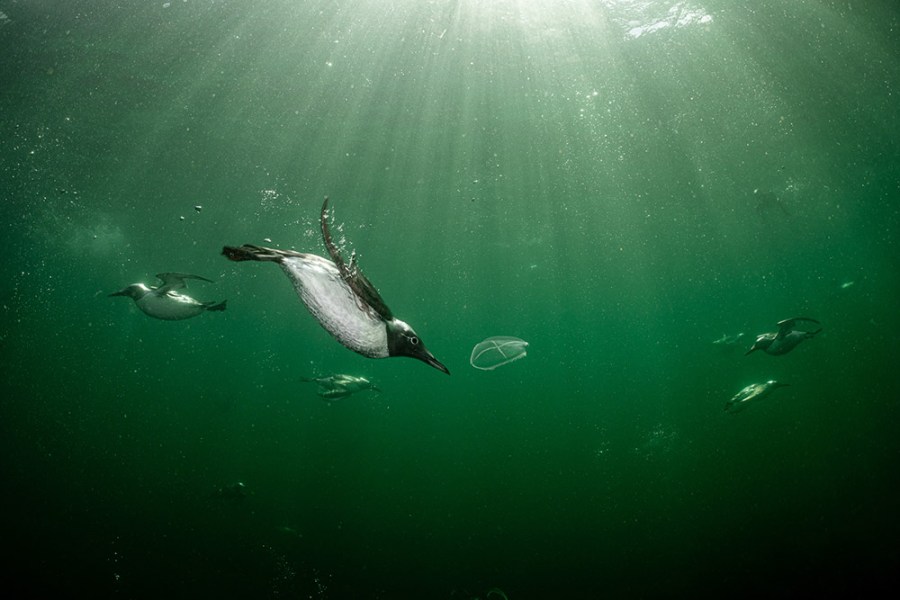The Bird Photographer of the Year 2022 winners have been unveiled. An image of a rock ptarmigan in winter plumage taking flight above the snow-covered mountains of Tysfjord, Norway, takes the grand prize in the world’s largest bird photography competition.
Photographers from all over the world entered more than 20,000 images into the competition, each with their eyes on the £5,000 grand prize. Norwegian photographer Erlend Haarberg was declared this year’s grand prize winner for his beautiful image taken above Tysfjorden.
‘High above the tree-line, the wind, snow and cold maintain the iron grip of winter for months on end. This is where Rock Ptarmigan thrive, small white feather-balls in an endless white landscape,’ says Haarberg. ‘On this particular winter day, I was on my way to a mountain top by Tysfjorden to photograph landscapes. I had almost reached the summit when I spotted some ptarmigan tracks criss-crossing between the rocks, where the wind had uncovered some sparse vegetation. From behind a rock, a small head appeared, and seconds later it took to the wing with the mountains and fjord landscape in the background, setting the scene perfectly.’

Rock Ptarmigan Flight, Rock Ptarmigan Lagopus muta. Tysfjord, Norway. Erlend Haarberg, Norway. Category: Overall Winner and Birds in the Environment. Gold Award Winner and Bird Photographer of the Year 2022. Nikon D850 with Nikon 70–200mm f/2.8 lens. Focal length 95mm; 1/2,500 second; f/10; ISO 800. © Erlend Haarberg / Bird Photographer of the Year
The Young Bird Photographer of the Year 2022 was awarded to 17-year-old Swiss photographer Levi Fitze for his image of a dunlin struggling against a sandstorm.
Fitze explained, ‘Last autumn I spent a week on the tiny North Sea island of Heligoland. The weather was quite bad and I didn’t see a single nice sunrise. However, the opportunity to observe all kind of shorebirds made up for the conditions. When I saw a group of Dunlin struggling with a small sandstorm, I decided to risk my equipment and attempt to photograph them. I could really see on their faces how annoyed they were by the wind and sand flying everywhere. I sympathised with them.‘
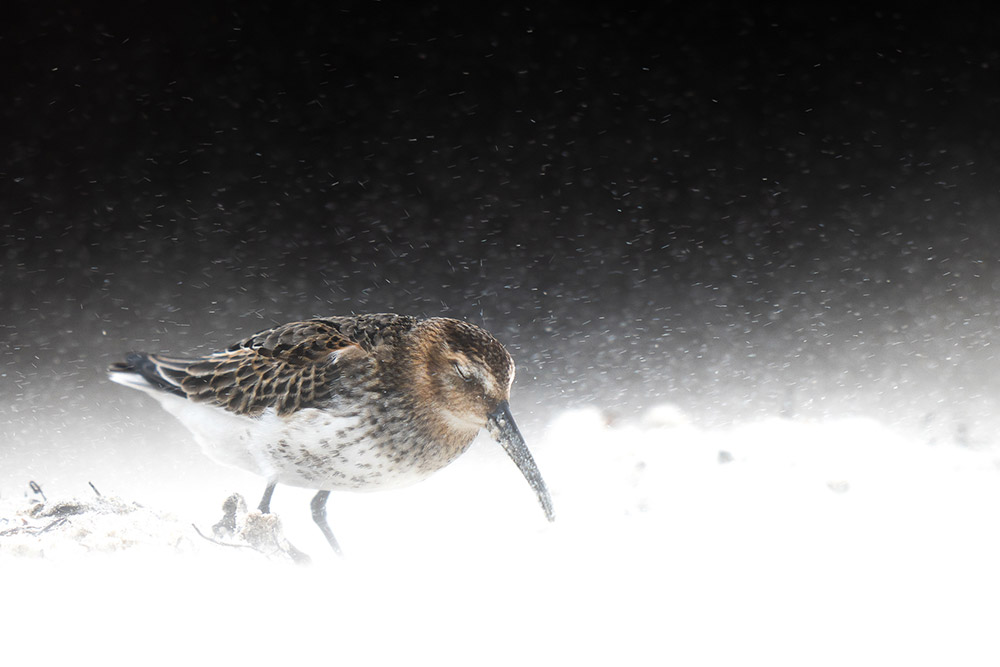
Facing the Storm. Dunlin Calidris alpina. Heligoland, Germany. Levi Fitze, Switzerland. Category: 14–17 years. Gold Award Winner and Young Bird Photographer of the Year 2022. Sony A7R IV with Sony 400mm f/2.8 GM lens. Focal length 400mm; 1/1,250 second; f/2.8; ISO 125. © Levi Fitze / Bird Photographer of the Year
‘Once again our talented photographers have cast a light on the incredible diversity of bird life that we share our planet with,’ says Will Nicholls, Director of Bird Photographer of the Year. ‘But it is also a stark reminder of what we stand to lose if we don’t continue to look after the natural world and fight for its protection from the many threats that exist today.’
See a selection of award winning photos from Bird Photographer of the Year 2022
Photographers competed in 8 different categories in the adult competition: Best Portrait, Birds in the Environment, Attention to Detail, Bird Behaviour, Birds in Flight, Black and White, Urban Birds, and Creative Imagery. There was also a Conservation Award, Portfolio Award, and Video Award.
Attention to Detail
Gold Award – Sleeping Beauty, Andy Pollard

Sleeping Beauty, King Penguin Aptenodytes patagonicus. Volunteer Point, Falkland Islands. Andy Pollard, Falkland Islands. Category: Attention to Detail. Gold Award Winner. Canon EOS 5D Mark IV with Canon 100–400mm f/4.5–5.6 II lens. Focal length 300mm; 1/160 second; f/8; ISO 500. © Andy Pollard / Bird Photographer of the Year
‘While most images of King Penguins seem to be of striking adult birds, there is a definite cuteness to the chicks in their brown ‘teddy bear’ plumage. This chick was asleep at Volunteer Point in the Falkland Islands, and I took the opportunity to capture the details around the beak, eye and ear, the latter seldom seen.‘
Bronze Award – Beads of Diamonds, Sue Dougherty
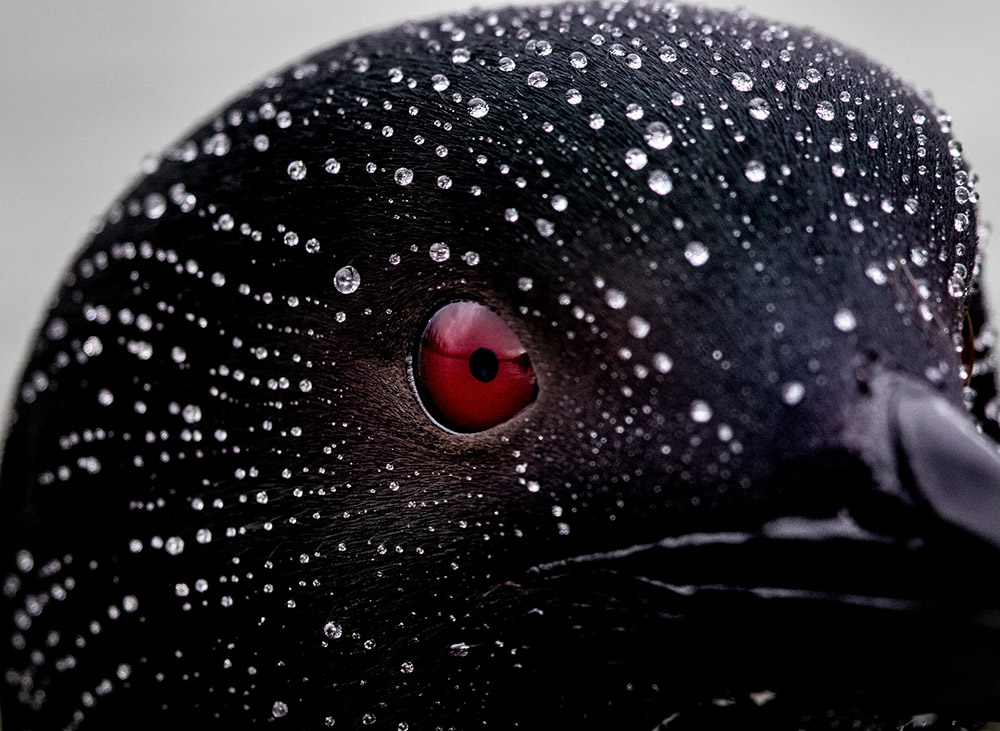
Beads of Diamonds. Great Northern Diver Gavia immer. Cariboo region, British Columbia, Canada. Sue Dougherty, United States of America. Category: Attention to Detail. Bronze Award Winner. Canon EOS 7D Mark II with Canon 500mm f/4 II lens and 1.4Å~ teleconverter. Focal length 700mm; 1/640 second; f/6.3; ISO 1,000. © Sue Dougherty / Bird Photographer of the Year
‘I spent some time in the Cariboo region of British Columbia photographing a very accommodating family of Common Loons (or Great Northern Divers as they are known in Europe). Using a boat with low sides and an electric motor, I was able to observe and photograph the birds without disrupting or affecting their behaviour. As I floated in silence, I watched the parent divers feed leeches and tiny fish to their chick – just days old – and they were unconcerned by my presence.
In fact, the adults actually approached the boat and made repeated dives under and around it. I was able to capture the moment this one surfaced with perfect hydrodynamic lines of water droplets adorning its head from beak to neck. They looked like glimmering beads of diamonds framing its ruby-red eye. Then, when I looked closely, I noted that the reflection in its eye was a ruby mirror of the trees on the lake shoreline.‘
Birds in the Environment
Silver Award – Kaleidoscope, Paul Mckenzie
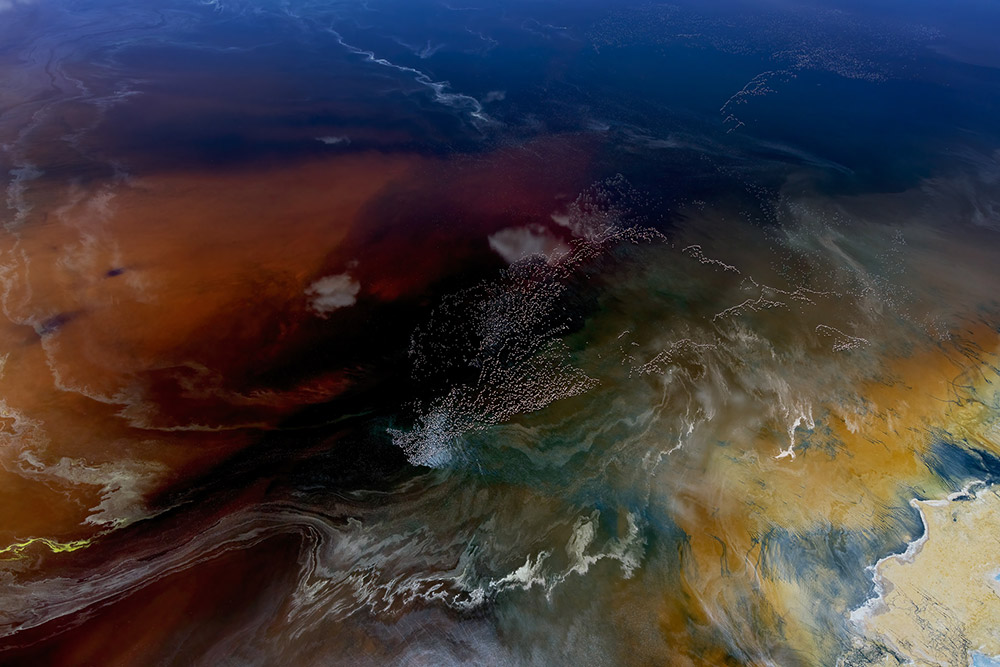
Kaleidoscope. Lesser Flamingo Phoeniconaias minor and Greater Flamingo Phoenicopterus roseus. Lake Logipi, Kenya. Paul Mckenzie, Ireland. Category: Birds in the Environment. Silver Award Winner. Canon R5 with Canon 24–105mm f/4 lens. Focal length 24mm; 1/3,200 second; f/5; ISO 500. © Paul Mckenzie / Bird Photographer of the Year
‘This image shows a small flock of Lesser and Greater flamingos as they fly over Lake Logipi in northern Kenya. Recent rains had covered the previously empty lake with a shallow depth of water. This had awakened dormant microscopic algae in the lake bed, which caused the red coloration in the image and mixed with yellow and brown sediment washed into the lake from the Suguta River.
High rates of evaporation resulting from searing air temperatures had begun to produce soda salt floes on the lake surface. Huge numbers of flamingos regularly gather on this remote lake to feed on the specialist brine invertebrates here, which themselves feed on the algae. I took this image from a light aircraft with the doors removed on one side.’
Bronze – Free as a Bird, Mario Suarez Porras
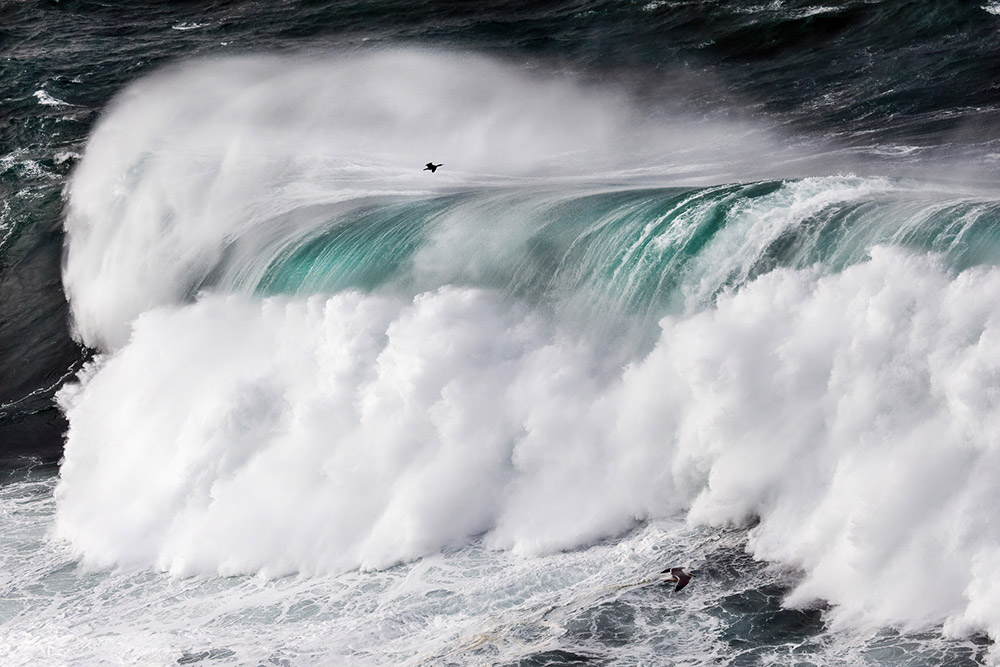
Free as a Bird, European Shag Gulosus aristotelis. Asturias, Spain. Mario Suarez Porras, Spain. Category: Birds in the Environment. Bronze Award Winner. Canon EOS 5D Mark IV with Canon 100–400mm f/4.5–5.6 II lens. Focal length 164mm; 1/4,000 second; f/8; ISO 1,250. © Mario Suarez Porras / Bird Photographer of the Year
‘This image shows a European Shag as it flies over a huge wave of about 8m high off the west coast of Asturias in northern Spain. It made me reflect on how lucky the bird was to be free and able to fly with strength and determination in the most difficult conditions.‘
Bird Behaviour
Silver Award – Guillemot Swimmers, Henley Spiers
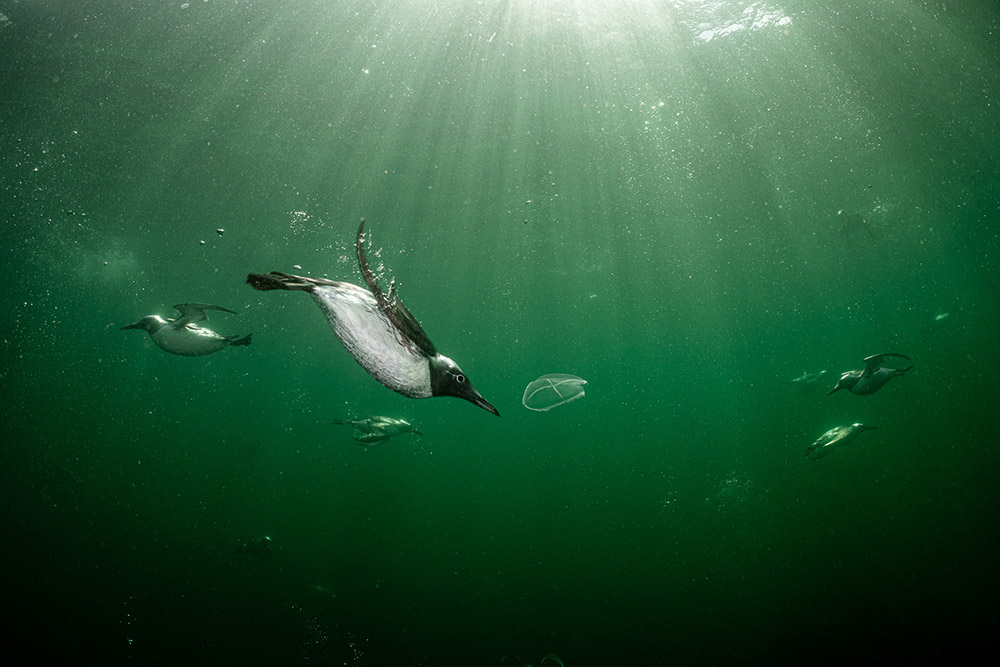
Guillemot Swimmers. Common Guillemot Uria aalge. Berwickshire Marine Reserve, Scotland. Henley Spiers, United Kingdom. Category: Bird Behaviour.
Silver Award Winner. Nikon D850 with Nikon 28–70mm f/3.5–4.5 lens. Focal length 28mm; 1/250 second; f/13; ISO 200. © Henley Spiers / Bird Photographer of the Year
‘Common Guillemots (Common Murres) are incredible freedivers – so good, in fact, that studies have shown that of all flying birds, this humble species is the most efficient swimmer. It is bested in the water only by penguins, with which it shares similar stylistic traits. The difference, of course, is that penguins – perhaps descended from the same auk family as Common Guillemots – sacrificed their ability to fly as they adapted to an aquatic existence.‘
Black and White
Gold Award – Between Two Worlds, Henley Spiers

Between Two Worlds, Double-crested Cormorant Nannopterum auritus. Espíritu Santo, Baja California Sur, Mexico. Henley Spiers, United Kingdom. Category: Black and White. Gold Award Winner. Nikon D850 with Nikon 28–70mm f/3.5–4.5 lens. Focal length 28mm; 1/500 second; f/8; ISO 500. © Henley Spiers / Bird Photographer of the Year
‘Ten metres down, I found myself hovering between two worlds. Below, an enormous school of fish covered the bottom as far as I could see. Above, a single Double-crested Cormorant patrolled the surface, catching its breath and peering down at a potential underwater feast. The cormorant, better designed for swimming than flying, would dive down at speed, aggressively pursuing the fish. The school would move in unison to escape the bird’s sharp beak, making it difficult to isolate a single target.
More often than not, the bird returned to the surface empty-billed, and peace would momentarily be restored. I would squint up at the sunny surface, trying to keep track of the predator and anticipate its next underwater raid. This image captures the hostile black silhouette of the cormorant as it dives down onto its prey, which for a brief moment remain unaware of the danger above.‘
Silver Award – The Guardian of Mordor, Paweł Smolik

The Guardian of Mordor. Great Cormorant Phalacrocorax carbo. Skarðsvík, Iceland.
Paweł Smolik, Poland. Category: Black and White. Silver Award Winner. Canon EOS 5D Mark IV with Canon 100–400mm f/4.5–5.6 II lens. Focal length 188mm; 1/500 second; f/8; ISO 100. © Paweł Smolik / Bird Photographer of the Year
‘The photo was taken on the black lava beach of Skarðsvík on the west coast of Iceland. While walking there I noticed that, after diving in the ocean, one of the area’s Great Cormorants would sit on a sharp, pointed ridge to dry its wings. The waves, which were unusually large that day, were crashing on nearby rocks, creating a floating mist of water. The sight of this cormorant with its black wings spread, combined with the aura of the place and the colour of the sand and rocks – all shades of black – reminded me of The Lord of the Rings movies. For this reason, and to emphasise the ominous sense of foreboding, I decided to present the photo in black and white.‘
Bronze Award – Winter Swans, Tomasz Sczansny

Winter Swans. Mute Swan Cygnus olor. Silesia, Poland. Tomasz Sczansny, Poland. Category: Black and White. Bronze Award Winner. DJI Phantom 4. Focal length 3.6mm; 1/100 second; f/2.8; ISO 183. © Tomasz Sczansny / Bird Photographer of the Year
‘I like looking at the world from an alternative perspective and, when I do, common species and familiar landscapes sometimes take on an otherworldly appearance and become extremely interesting. I encounter Mute Swans regularly on this lake, but this was the first time I had photographed them using a drone. I took this image not far from my home, while the lake was frozen. The ice paints the landscape with beautiful shapes and the swans add context, the whole scene working particularly well in black and white. Such a situation was probably a one-off and will never be repeated.‘
Creative Imagery
Gold Award – Van Gogh’s Storks, Petro Katerynych
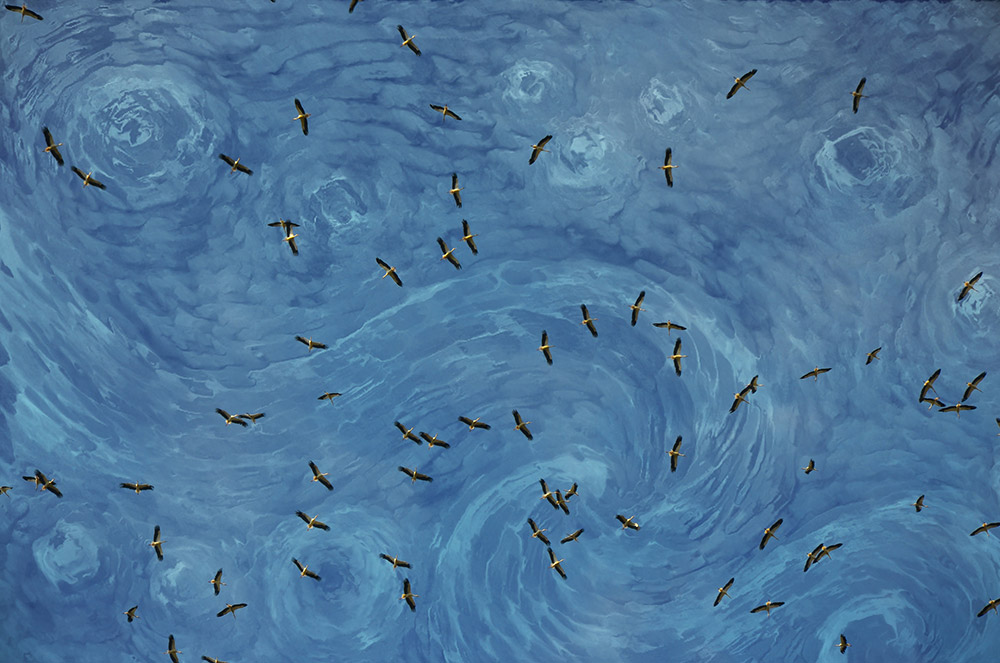
Van Gogh’s Storks, White Stork Ciconia ciconia. Ukraine. Petro Katerynych, Ukraine. Category: Creative Imagery. Gold Award Winner. Nikon D5100 with Nikon 18–105mm f/3.5–5.6 lens. Focal length 105mm; 1/320 second; f/9; ISO 100. © Petro Katerynych / Bird Photographer of the Year
‘In Ukrainian mythology White Storks symbolise faithfulness and strength of spirit. It is hard to imagine a Ukrainian village without a stork’s nest. Everywhere, from Polesia to Slobozhanshchyna, White Storks are seen as a symbol of love for their motherland. When spring arrives and storks return home, Ukrainians young and old go out into the streets, greet the birds’ arrival and sing traditional songs called Vesnyanki in celebration.
Ukrainians cherish spring, which brings prosperity and hope, and we feel that happiness will undoubtedly bless any house where a stork settles and decides to nest. Storks also set a good example and serve to remind Ukrainians how important it is to love our homeland. They fly thousands of kilometres to warmer lands when there is a bitter winter. But they always come back, overcoming all the hardships that beset them on their journey.
We believe that love for their native land gives the storks the strength to survive and return home. Ukrainians don’t traditionally give birds and animals human names. However, an exception is made with White Storks, which are addressed as if they were people. My fellow Ukrainians are facing a similarly challenging task right now – once again they must defend their native nests, while some are forced to rush like storks in the direction of the sun. Many of us will fall, but I hope that spring is ahead of us. I believe that most of us will live to see the return of White Storks circling overhead in the peaceful skies of a free Ukraine. Then we will all rally together, and sing Vesnyanki once more.‘
Bronze Award – Sandhill Crane Flight Team Air Show, Wei Lian
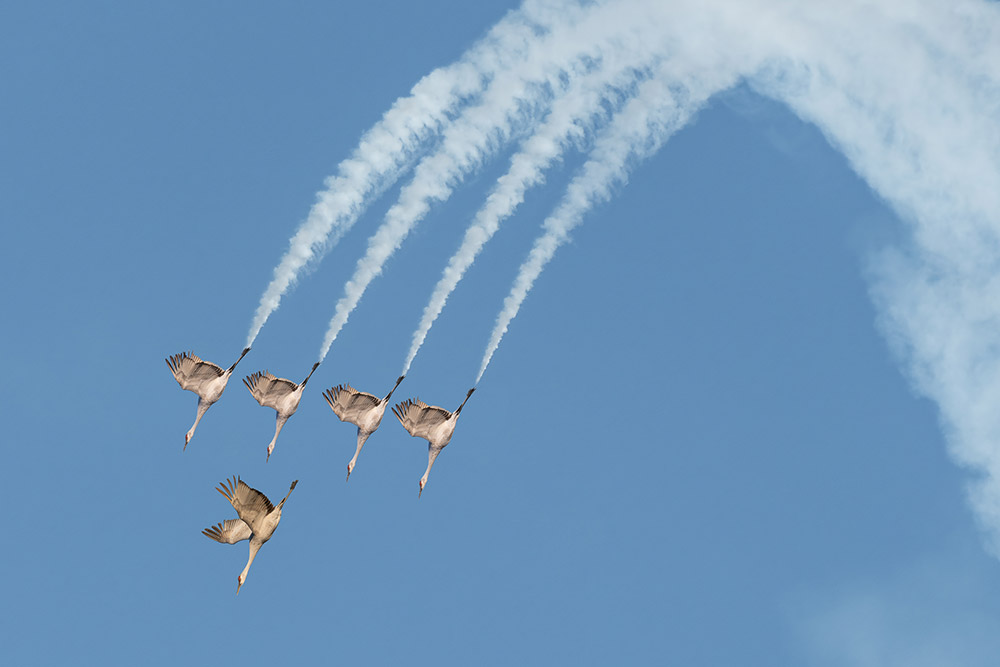
Sandhill Crane Flight Team Air Show. Sandhill Crane Grus canadensis. San Francisco, California, United States of America. Wei Lian, United States of America. Category: Creative Imagery. Bronze Award Winner. Nikon D850 with Nikon 80–400mm f/4.5–5.6 lens. Focal length 400mm; 1/3,200 second; f/9; ISO 720. Composite. © Wei Lian / Bird Photographer of the Year
‘Last October, I went to San Francisco in California to watch the spectacle of the annual US Navy Blue Angels military air show. The performance was wonderful, and I took a lot of photos. Inspired by the aerobatic skills of the Blue Angels, I decided to incorporate a formation of Sandhill Cranes into the scene, and created this image using several pictures that I blended and combined.‘
Urban Birds
Gold Award – Over the City, Ammar Alsayed Ahmed
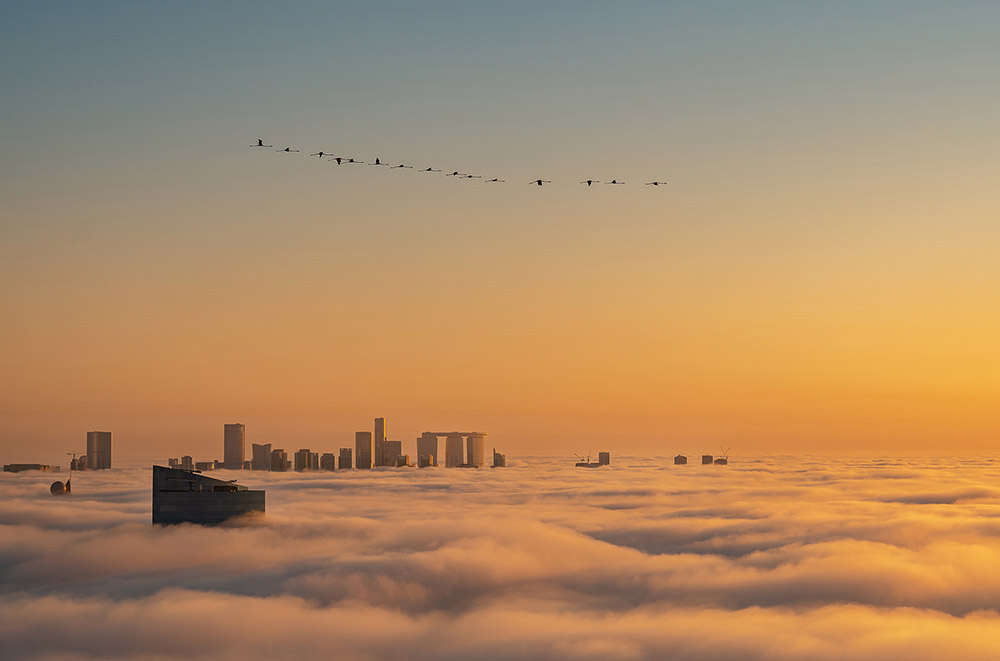
Over the City, Greater Flamingo Phoenicopterus roseus. Abu Dhabi, United Arab Emirates. Ammar Alsayed Ahmed, United Arab Emirates. Category: Urban Birds. Gold Award Winner. Nikon Z 6 II with Nikon 70–200mm f/2.8 lens. Focal length 71mm; 1/500 second; f/7.1; ISO 100. © Ammar Alsayed Ahmed / Bird Photographer of the Year
‘This image was taken from the rooftop of one of the towering skyscraper buildings that dominate the skyline of Abu Dhabi. It shows a line of Greater Flamingos flying on a morning when fog covered the city and the only signs of the urban landscape were the tops of the buildings emerging from the blanket of mist. At the time it seemed a bit like a fantasy, a fleeting moment made surreal as the birds unexpectedly flew past. Fortunately, I was prepared for action and my zoom lens allowed me to frame the birds and capture the moment.‘
Silver Award – Gonzo, Laszlo Ptozky

Gonzo, Little Owl Athene noctua. Harghita county, Transylvania, Romania. Laszlo Potozky, Romania. Category: Urban Birds. Silver Award Winner. Sony A7R IV with Sony 200–600mm f/5.6–6.3 G lens. Focal length 600mm; 1/60 second; f/6.3; ISO 400. © Laszlo Potozky / Bird Photographer of the Year
‘This image was taken in Transylvania in Romania, not far from one of my favourite Natura 2000 sites. Only rarely are there days when this highly respected protected area fails to deliver from a bird photography point of view. However, on such days I know I have a fall-back option, namely an abandoned building where Little Owls have nested for more than a decade.
Last year, on one of these Plan B days, I arrived at the building following heavy rain and discovered that the Little Owl family had grown: three chicks had hatched a few weeks previously. To my relief, I was ‘welcomed’ by the whole family, and while four of them were drying their feathers on the roof, one of the chicks was under it, posing in an odd way and with what looked like an air of resignation. To my eyes I could see a resemblance to Gonzo, the famous character from The Muppet Show.‘
8 and under
Hoot Are You?, Arjun Jenigiri
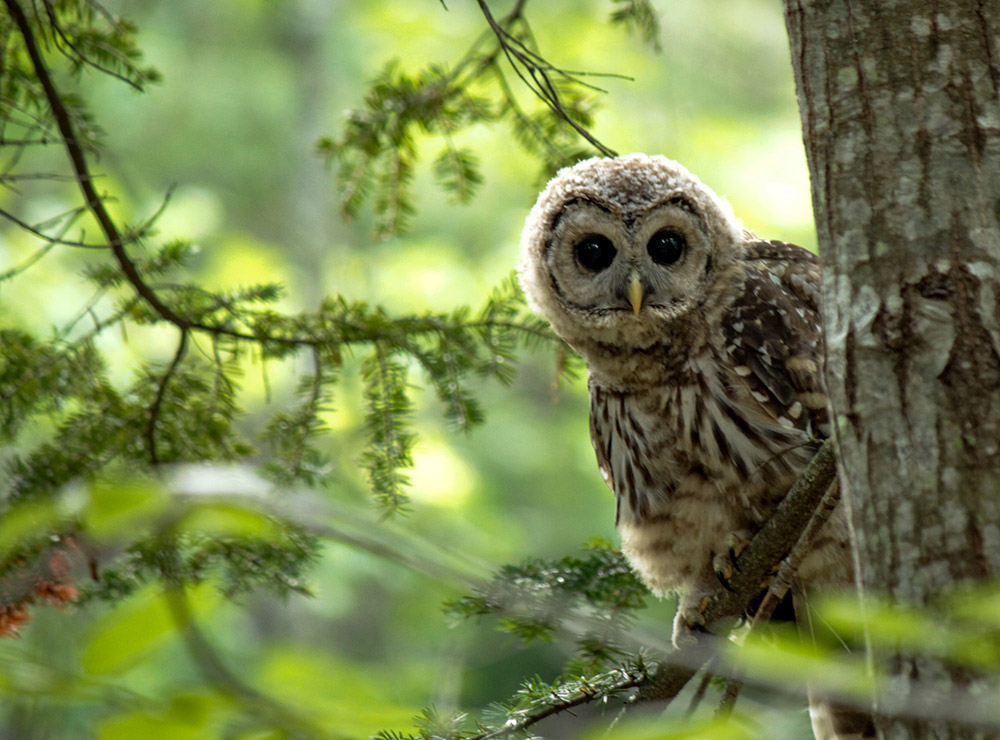
Hoot Are You? Barred Owl Strix varia. Acadia National Park, Maine, United States of America. Arjun Jenigiri, United States of America. Category: 8 and under.
Gold Award Winner. Canon EOS 700D with Canon 55–250mm f/4–5.6 lens. Focal length 250mm; 1/30 second; f/7.1; ISO 1,600. © Laszlo Potozky / Bird Photographer of the Year
‘One of my parents’ friends, who lives nearby, took us on a hike to a location where she had seen Barred Owl chicks earlier in the week. Amazingly, we were just a few minutes into the hike when we heard them calling. Eventually we got to see four owlets, which was amazing. One landed close by and peered at me from behind a tree trunk in a way that seemed to express curiosity. I was thrilled to be able to capture the moment and pleased that the judges appreciated the photo.‘
9 – 13 Year Olds
Gold Award – Droplets, Parham Pourahmad
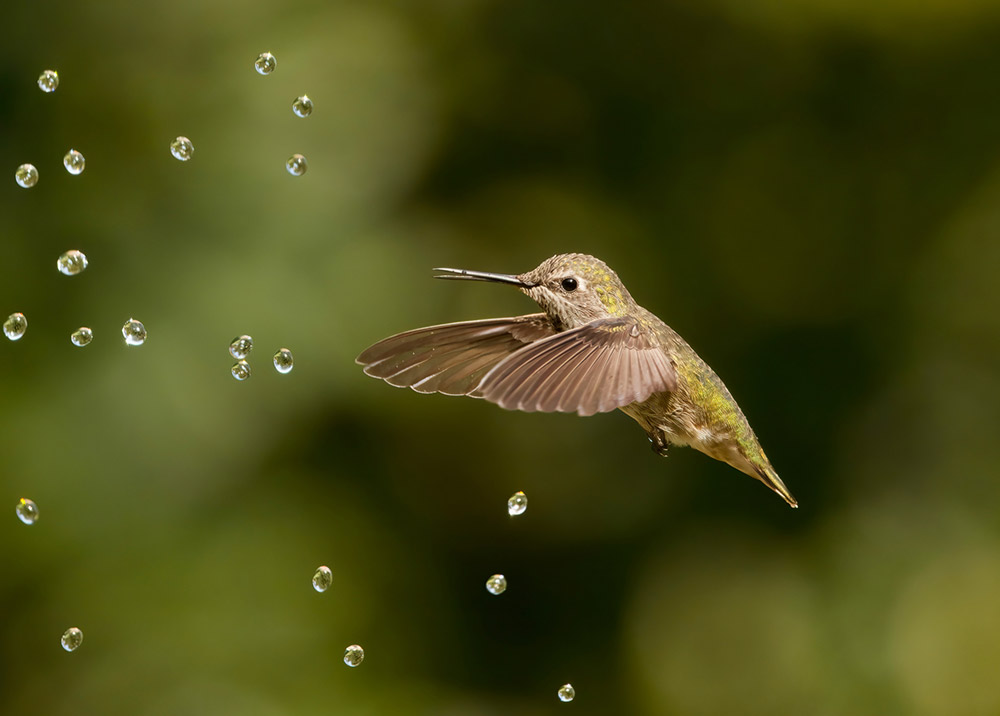
Droplets. Anna’s Hummingbird Calypte anna. Fremont, California, United States of America. Parham Pourahmad, United States of America. Category: 9–13 years. Gold Award Winner. Nikon D3500 with Sigma 150–600mm f/5–6.3 lens. Focal length 600mm; 1/4,000 second; f/6.3; ISO 2,800. © Parham Pourahmad / Bird Photographer of the Year
‘In Fremont there is a water fountain that is a hotspot for hummingbirds. The birds like to bathe in the water, or in this case catch and sip the droplets. When the birds fly around among the droplets, it provides great opportunities for photography. I had to use a very fast shutter speed to freeze the water droplets and the wings of this Anna’s Hummingbird.‘
14 – 17 Year Olds
Silver Award – Pied Avocet Chick, Tamás Koncz-Bisztricz

Pied Avocet Chick. Pied Avocet Recurvirostra avosetta. Kinskunság National Park, Hungary. Tamás Koncz-Bisztricz, Hungary. Category: 14–17 years.
Silver Award Winner. Canon EOS-1D X with Canon 400mm f/4 II lens and 1.4x teleconverter. Focal length 560mm; 1/3,200 second; f/5.6; ISO 100. © Tamás Koncz-Bisztricz / Bird Photographer of the Year
‘This photograph was taken in an area I have known for a long time – it is a soda lake called Nagyszéksós-tó, near the town of Mórahalom. Kinskunság National Park introduced Water Buffalos (Bubalus bubalis) at least ten years ago, and the beneficial outcome has been that the birdlife has become very rich and diverse. Until now, I have photographed only adult birds at this location, but I managed to observe and photograph Pied Avocet chicks in early summer.
After prolonged observation, I edged my way closer to the birds. The parent birds soon overcame any nervousness and soon got used to my presence; I was an insignificant addition to the nearby Water Buffalos, which dwarfed me. The chicks went about their business a few metres away from me, and fed and preened quite happily. I was lucky enough to be able to photograph this chick backlit, and as a result I took some really special images.‘
Bronze Award – Sunset, Thamboon Uyyanonvara
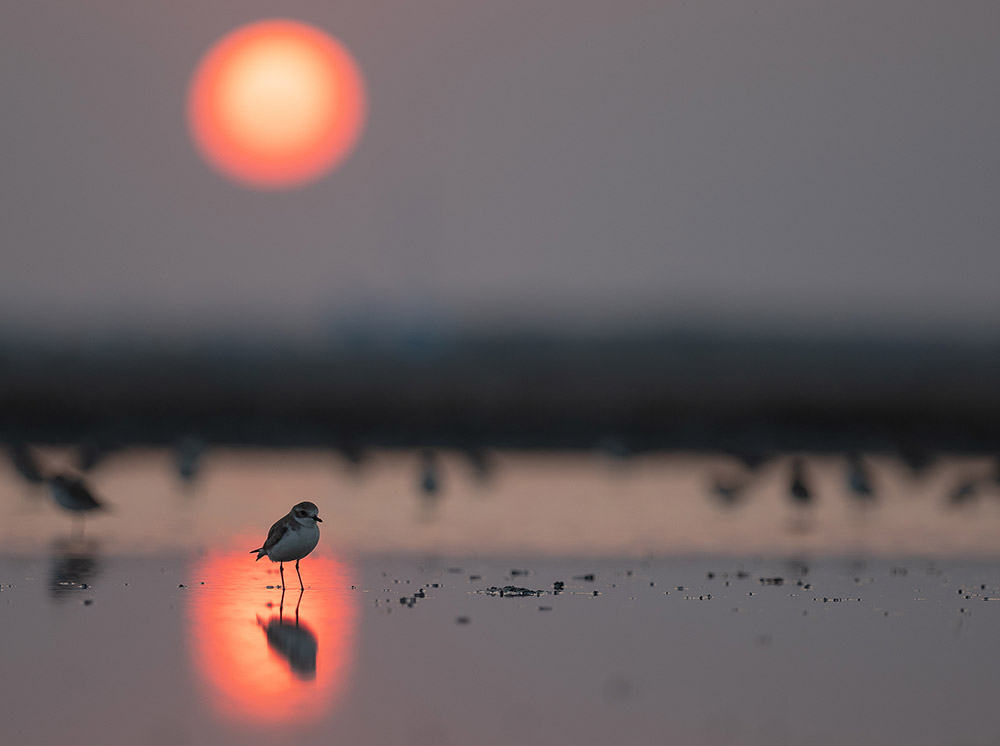
Sunset. Kentish Plover Charadrius alexandrinus. Khok Kham, Samut Sakhon, Thailand. Thamboon Uyyanonvara, Thailand. Category: 14–17 years. Bronze Award Winner. Canon R6 with Canon 300mm f/2.8 II lens. Focal length 300mm; 1/500 second; f/2.8; ISO 100. © Thamboon Uyyanonvara / Bird Photographer of the Year
‘At the end of the day, this area of saltpans took on a beautiful, bright orange-red colour. I love watching the scene of waders foraging in such glorious light. To take this photograph, I lay prone and motionless on a low ridge as there was nowhere else for me to hide. I lay there hoping that the birds would come into the basin just in front of me.
Eventually, my dream came true and the birds finally arrived, right on cue to coincide with the gorgeous sunset light. The sun’s glow contained tints of yellowish, pinkish and orange-red, and this little Kentish Plover was perfectly placed in the middle of its reflection on the saltwater surface. You can also get a sense of how shallow the basin was from the size of the bird in relation to those little wads of mud.‘
Bird Photographer of the Year has conservation at its heart. This year, the competition donated more than £5,000 to partner charity Birds on the Brink, which provides vital funding to grass-roots bird conservation projects around the world.
All awarded images are published by William Collins in a hard-back coffee-table book, which is now available online at birdpoty.com. Foreword by naturalist and TV explorer Steve Backshall. (HB, £30, published 15th September).
Enter Bird Photographer of the Year 2023
The 2023 competition is now open for entries at birdpoty.com, and invites photographers of all experience levels to submit their best bird photos. Competition closes for entries on 11 December 2022.
See more photography competitions here.
Further reading:
How to capture garden birds in flight
How to shoot wildlife photography – beginners guide

